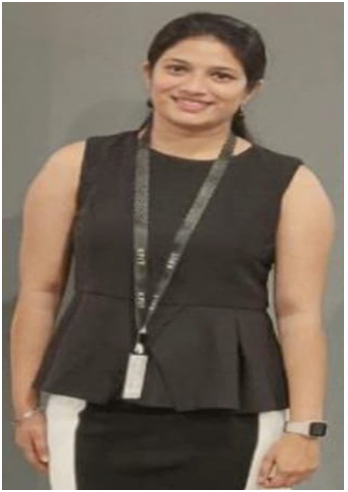Yogesh R. Risodkar
Asst. Prof. and HEAD
Department of E&TC Engineering
8411088992
yogesh.risodkar@siem.org.in
Electronics & Telecommunication Engineering
Electronics aims at making the life of human beings comfortable. Communication connects people and brings them together. The vast application of electronics and the rapid advancements in the field of communications makes the study of this branch a covered option. The department’s teaching areas include network, microprocessor, communications, signal and image processing, pattern recognition, electronic circuits, solid-state electronics, microwave electronics, system and control, electronics, VLSI, CAD, parallel and distributed processing and wireless communication.
Keeping in line with fast changing technological developments, the department has well designed laboratories with modern equipments like Spectrum Analyzer, Logic Analyzer, DSO and advanced software’s like MATLAB, Proteus, Cadence, to incorporate all advancements in existing and emerging technologies. The state-of-the-art laboratories complement the high standards set by the competitive syllabus and nurture the inclination of the students towards research and development, besides giving them the necessary and sufficient backing of practical knowledge that they need.
Technophilia2k23
Vision
- To excel in the field of Electronics and Telecommunication Engineering so as to create competent professionals focusing on the needs of industry and society with processional ethics.
Mission
- To empower competent graduates for applying knowledge and skill sets to face global challenges and societal needs by achieving excellence in innovation.
- To provide a platform for budding graduates to apply and solve real life problems using cutting edge technologies through their creative abilities aimed at fulfilling the needs of society and industry.
- To cultivate ethical values in graduates for their Internationalisation.
Program Educational Objectives
- Graduates will exhibit knowledge in Mathematics, Engineering fundamentals, Electronics and Telecommunication Engineering and related fields for professional achievement in industry and organisation.
- Graduates will have thorough knowledge in Electronics and Tele-communication Engineering to innovate, design and develop modern Electronic systems.
- Graduates will be able to identify, analyze and apply Engineering concepts for design of Electronics and Telecommunication Systems to meet existing requirements of Industry.
- Graduates will preserve intellectual inquisitiveness in professional career through lifelong learning, adapt to evolving technology, work in multidisciplinary area to design innovative products and become entrepreneurs.
- Graduates will be able to function with leadership qualities, team spirit, managerial skills, attitude and ethics needed for successful career and entrepreneurship for the betterment of industry and society.
Program Outcomes
- Engineering knowledge: The subtitles first letter should be in capital letters for eg. Engineering Knowledge, Problem Analysis, Design/Development of Solutions.
- Problem analysis: Graduates will identify, formulate and analyze complex problems in real world using principles of science and engineering
- Design/Development of Solutions : Graduates will design system component to satisfy the desired needs within realistic constraints such as economic, environmental, social, political, ethical, health, safety and sustainability.
- Conduct investigations of complex problems: Graduates will conduct experiments, analyze and interpret experimental results pertaining to Electronic systems.
- Modern tool usage: Graduates will apply techniques, skills, modern electronic systems and computer aided software tools necessary for solving electronics and telecommunication engineering problems.
- The engineer and society: Graduates will exhibit awareness of existing engineering problems.
- Environment and sustainability: Graduates will understand the impact of engineering solutions in a global, economic, environmental, and societal context.
- Ethics: Graduates will understand and apply professional and ethical responsibility.
- Individual and team work: Graduates will identify the areas of interest and functions as an individual and as a member or leader in multidisciplinary teams.
- Communication: Graduates will communicate facts successfully with people in engineering domain and effectively design and prepare documents and reports.
- Project management and finance: Graduates will demonstrate the understanding of management principles as applied to the specified work and apply this knowledge to manage the projects as a member and leader in a team.
- Life-long learning: Graduates will acquire knowledge of contemporary issues and recognize the need for life-long learning.
Program Specific Outcomes (PSO)
- PSO1: Professional Skills: An ability to design and implement complex systems in emerging sectors like embedded, Microelectronics and Advanced Communication Systems.
- PSO2: Problem-Solving Skills: An ability to apply Engineering knowledge to solve real time problems using modern hardware and software tools and to work in team with ethical and social responsibility.
- PSO3: Successful Career and Entrepreneurship: An ability to make use of acquired technical knowledge for exploring employment opportunities and qualifying in various competitive examinations.
Class: Second Year Engineering (SE) 2019 Pattern
Semester: I
Subject: Engineering Mathematics III
Subject Code: 207005
| CO1 | Solve higher order linear differential equation using appropriate techniques for modeling, analyzing of electrical circuits and control systems. |
| CO2 | Apply concept of Fourier transform & Z-transform and its applications to continuous & discrete systems, signal & image processing and communication systems. |
| CO3 | Obtain Interpolating polynomials, numerically differentiate and integrate functions, numerical solutions of differential equations using single step and multi-step iterative methods used in modern scientific computing. |
| CO4 | Perform vector differentiation & integration, analyze the vector fields and apply to electro- magnetic fields & wave theory. |
| CO5 | Analyze Complex functions, Conformal mappings, Contour integration applicable to electrostatics, digital filters, signal and image processing |
Subject: Electronic Circuits
Subject Code: 204181
| CO1 | Assimilate the physics, characteristics and parameters of MOSFET towards its application as amplifier. |
| CO2 | Design MOSFET amplifiers, with and without feedback, & MOSFET oscillators, for given specifications. |
| CO3 | Analyze and assess the performance of linear and switching regulators, with their variants, towards applications in regulated power supplies. |
| CO4 | Explain internal schematic of Op-Amp and define its performance parameters. |
| CO5 | Design, Build and test Op-amp based analog signal processing and conditioning circuits towards various real time applications. |
| CO6 | Understand and compare the principles of various data conversion techniques and PLL with their applications. |
Subject: Digital Circuits
Subject Code: 204182
| CO1 | Identify and prevent various hazards and timing problems in a digital design. |
| CO2 | Use the basic logic gates and various reduction techniques of digital logic circuit. |
| CO3 | Analyze, design and implement combinational logic circuits. |
| CO4 | Analyze, design and implement sequential circuits. |
| CO5 | Differentiate between Mealy and Moore machines. |
| CO6 | Analyze digital system design using PLD. |
Subject: Electrical Circuits
Subject Code: 204183
| CO1 | Analyze the simple DC and AC circuit with circuit simplification techniques. |
| CO2 | Formulate and analyze driven and source free RL and RC circuits. |
| CO3 | Formulate & determine network parameters for given network and analyze the given network using Laplace Transform to find the network transfer function. |
| CO4 | Explain construction, working and applications of DC Machines / Single Phase & Three Phase AC Motors. |
| CO5 | Explain construction, working and applications of special purpose motors & understand motors used in electrical vehicles |
| CO6 | Analyze and select a suitable motor for different applications. |
Subject: Data Structures
Subject Code: 204184
| CO1 | Solve mathematical problems using C programming language. |
| CO2 | Implement sorting and searching algorithms and calculate their complexity. |
| CO3 | Develop applications of stack and queue using array. |
| CO4 | Demonstrate applicability of Linked List. |
| CO5 | Demonstrate applicability of nonlinear data structures – Binary Tree with respect to its time complexity. |
| CO6 | Apply the knowledge of graph for solving the problems of spanning tree and shortest path algorithm. |
Semester: II
Subject: Signals & Systems
Subject Code: 204191
| CO1 | Identify, classify basic signals and perform operations on signals |
| CO2 | Identify, Classify the systems based on their properties in terms of input output relation and in terms of impulse response and will be able to determine the convolution between to signal |
| CO3 | Analyze and resolve the signals in frequency domain using Fourier series and Fourier Transform |
| CO4 | Resolve the signals in complex frequency domain using Laplace Transform, and will be able to apply and analyze the LTI systems using Laplace Transforms |
| CO5 | Define and Describe the probability, random variables and random signals. Compute the probability of a given event, model, compute the CDF and PD |
| CO6 | Compute the mean, mean square, variance and standard deviation for given random variables using PDF |
Subject: Control Systems
Subject Code: 204192
| CO1 | Determine and use models of physical systems in forms suitable for use in the analysis and design of control systems. |
| CO2 | Determine the (absolute) stability of a closed-loop control system |
| CO3 | Perform time domain analysis of control systems required for stability analysis. |
| CO4 | Perform frequency domain analysis of control systems required for stability analysis. |
| CO5 | Apply root-locus, Frequency Plots technique to analyze control systems |
| CO6 | Express and solve system equations in state variable form. |
| CO7 | Differentiate between various digital controllers and understand the role of the controllers in Industrial automation. |
Subject: Principles of Communication Systems
Subject Code: 204193
| CO1 | To compute & compare the bandwidth and transmission power requirements by analyzing time and frequency domain spectra of signal required for modulation schemes under study |
| CO2 | Describe and analyze the techniques of generation, transmission and reception of Amplitude Modulation Systems. |
| CO3 | Explain generation and detection of FM systems and compare with AM systems. |
| CO4 | Exhibit the importance of Sampling Theorem and correlate with Pulse Modulation technique (PAM, PWM, and PPM) |
| CO5 | Characterize the quantization process and elaborate digital representation techniques (PCM, DPCM, DM and ADM). |
| CO6 | Illustrate waveform coding, multiplexing and synchronization techniques and articulate their importance in baseband digital transmission. |
Subject: Object Oriented Programming
Subject Code: 204194
| CO1 | Describe the principles of object oriented programming. |
| CO2 | Apply the concepts of data encapsulation, inheritance in C++. |
| CO3 | Understand Operator overloading and friend functions in C++. |
| CO4 | Apply the concepts of classes, methods inheritance and polymorphism to write programs C++. |
| CO5 | Apply Templates, Namespaces and Exception Handling concepts to write programs in C++. |
| CO6 | Describe and use of File handling in C++. |
Subject: Employability Skills Development
Subject Code: 204199
| CO1 | Define personal and career goals using introspective skills and SWOC assessment. Outline and evaluate short-term and long-term goals. |
| CO2 | Develop effective communication skills (listening, reading, writing, and speaking), self- management attributes, problem solving abilities and team working & building capabilities in order to fetch employment opportunities and further succeed in the workplace |
| CO3 | Be a part of a multi-cultural professional environment and work effectively by enhancing inter-personal relationships, conflict management and leadership skills. |
| CO4 | Comprehend the importance of professional ethics, etiquettes & morals and demonstrate sensitivity towards it throughout certified career. |
| CO5 | Develop practically deployable skill set involving critical thinking, effective presentations and leadership qualities to hone the opportunities of employability and excel in the professional environment. |
Subject: Data Analytics Lab
Subject Code: 204198
| CO1 | To introduce to students fundamentals of data science. |
| CO2 | To introduce to students various Python packages related to data science. |
| CO3 | To make student write Python programs related to data sequences using NumPy and Pandas. |
| CO4 | To make student write Python programs related to data frames using NumPy and Pandas. |
Class: Third Year Engineering (TE) 2019 Pattern
Semester: I
Subject: Digital Communication
Subject Code: 304181
| CO1 | Apply the statistical theory for describing various signals in a communication system. |
| CO2 | Understand and explain various digital modulation techniques used in digital communication systems and analyze their performance in presence of AWGN noise. |
| CO3 | Describe and analyze the digital communication system with spread spectrum modulation. |
| CO4 | Analyze a communication system using information theoretic approach. |
| CO5 | Use error control coding techniques to improve performance of a digital communication system. |
Subject: Electromagnetic Field Theory
Subject Code: 304182
| CO1 | Apply the basic electromagnetic principles and determine the fields (E & H) due to the given source. |
| CO2 | Apply boundary conditions to the boundaries between various media to interpret behavior of the fields on either sides. |
| CO3 | State, Identify and Apply Maxwell’s equations (integral and differential forms) in both the forms (Static, time-varying or Time-harmonic field) for various sources, Calculate the time average power density using Poynting Theorem, Retarded magnetic vector potential. |
| CO4 | Formulate, Interpret and solve simple uniform plane wave (Helmholtz Equations) equations, and analyze the incident/reflected/transmitted waves at normal incidence. |
| CO5 | Interpret and Apply the transmission line equation to transmission line problems with load impedance to determine input and output voltage/current at any point on the Transmission line, Find input/load impedance, input/load admittance, reflection coefficient, SWR, Vmax/Vmin, length of transmission line using Smith Chart. |
| CO6 | Carry out a detailed study, interpret the relevance and applications of Electromagnetics. |
Subject: Database Management
Subject Code: 304183
| CO1 | Ability to implement the underlying concepts of a database system |
| CO2 | Design and implement a database schema for a given problem-domain using data model. |
| CO3 | Formulate, using SQL/DML/DDL commands, solutions to a wide range of query and update problems. |
| CO4 | Implement transactions, concurrency control, and be able to do Database recovery. |
| CO5 | Able to understand various Parallel Database Architectures and its applications. |
| CO6 | Able to understand various Distributed Databases and its applications. |
Subject: Microcontrollers
Subject Code: 304184
| CO1 | Understand the fundamentals of microcontroller and programming. |
| CO2 | Interface various electronic components with microcontrollers. |
| CO3 | Analyze the features of PIC 18F XXXX. |
| CO4 | Describe the programming details in peripheral support. |
| CO5 | Develop interfacing models according to applications. |
| CO6 | Evaluate the serial communication details and interfaces. |
Subject: Computer Networks (Elective – I)
Subject Code: 304185 (D)
| CO1 | Design LAN using appropriate networking architecture, topologies, transmission media, and networking devices. |
| CO2 | Understand the working of controlling techniques for flawless data communication using data link layer protocols. |
| CO3 | Learn the functions of network layer, various switching techniques and internet protocol addressing. |
| CO4 | Explore various interior and exterior, unicasting and multicasting protocols. |
| CO5 | Analyze data flow using TCP/UDP Protocols, congestion control techniques for QoS. |
| CO6 | Illustrate the use of protocols at application layer. |
Subject: Skill Development
Subject Code: 304190
| CO1 | Student should recognize the need to engage in independent and life-long learning in required skill sets |
| CO2 | Student needs to experience the impact of industries on society by visiting different industries and understand the importance of industrial products for analog and digital circuits and systems. |
| CO3 | Student has to make use of the modern electronic and IT Engineering Tools and Technologies for solving electronic engineering problems. |
| CO4 | Student would be able to communicate effectively at different technical and administrative levels. |
| CO5 | Student will exhibit leadership skills both as an individual and as a member in a team in multidisciplinary environment. |
Semester: II
Subject: Cellular Networks
Subject Code: 304192
| CO1 | Understand fundamentals of wireless communications. |
| CO2 | Discuss and study OFDM and MIMO concepts. |
| CO3 | Elaborate fundamentals mobile communication. |
| CO4 | Describes aspects of wireless system planning. |
| CO5 | Understand of modern and futuristic wireless networks architecture. |
| CO6 | Summarize different issues in performance analysis. |
Subject: Project Management
Subject Code: 304193
| CO1 | Apply the fundamental knowledge of project management for effectively handling the projects. |
| CO2 | Identify and select the appropriate project based on feasibility study and undertake its effective planning. |
| CO3 | Assimilate effectively within the organizational structure of project and handle project management related issues in an efficient manner. |
| CO4 | Apply the project scheduling techniques to create a Project Schedule Plan and accordingly utilize the resources to meet the project deadline. |
| CO5 | Identify and assess the project risks and manage finances in line with Project Financial Management Process. |
| CO6 | Develop new products assessing their commercial viability and develop skillsets for becoming successful entrepreneurs while being fully aware of the legal issues related to Product development and Entrepreneurship. |
Subject: Power Devices & Circuits
Subject Code: 304194
| CO1 | To differentiate based on the characteristic parameters among SCR, GTO, MOSFET & IGBT and identify suitability of the power device for certain applications and understand the significance of device ratings. |
| CO2 | To design triggering / driver circuits for various power devices. |
| CO3 | To evaluate and analyze various performance parameters of the different converters and its topologies. |
| CO4 | To understand significance and design of various protections circuits for power devices. |
| CO5 | To evaluate the performance of uninterruptible power supplies, switch mode power supplies and battery. |
| CO6 | To understand case studies of power electronics in applications like electric vehicles, solar systems etc. |
Subject: Digital Image Processing (Elective – II)
Subject Code: 304195 (A)
| CO1 | Apply knowledge of mathematics for image understanding and analysis. |
| CO2 | Implement spatial domain image operations. |
| CO3 | Design and realize various algorithms for image segmentation. |
| CO4 | Design and realize various algorithms for image Compression. |
| CO5 | Apply restoration to remove noise in the image. |
| CO6 | Describe the object recognition system. |
Subject: Internship
Subject Code: 304199
| CO1 | To develop professional competence through internship. |
| CO2 | To apply academic knowledge in a personal and professional environment. |
| CO3 | To build the professional network and expose students to future employees |
| CO4 | Apply professional and societal ethics in their day to day life. |
| CO5 | To become a responsible professional having social, economic and administrative considerations. |
| CO6 | To make own career goals and personal aspirations |
Subject: Mini Project
Subject Code: 304200
| CO1 | Understand, plan and execute a Mini Project with team. |
| CO2 | Implement electronic hardware by learning PCB artwork design, soldering techniques, testing and
troubleshooting etc. |
| CO3 | Prepare a technical report based on the Mini project |
| CO4 | Deliver technical seminar based on the Mini Project work carried out. |
Subject: Embedded Processors (Elective – II)
Subject Code: 304195 (D)
| CO1 | To develop professional competence through internship. |
| CO2 | To apply academic knowledge in a personal and professional environment. |
| CO3 | To build the professional network and expose students to future employees. |
| CO4 | Apply professional and societal ethics in their day to day life. |
| CO5 | To become a responsible professional having social, economic and administrative considerations |
| CO6 | To make own career goals and personal aspirations. |
Class: Final Year Engineering (BE) 2019 Pattern
Semester: I
Subject: Radiation and Microwave Theory
Subject Code: 404181
| CO1 | Apply the fundamentals of electromagnetic to derive free space propagation equation and distinguish various performance parameters of antenna. |
| CO2 | Identify various modes in the waveguide. Compare: coaxial line, rectangular waveguides & striplines and identify applications of the same. |
| CO3 | Explore construction and working of principles passive microwave devices/components. |
| CO4 | Explore construction and working of principles active microwave devices/components. |
| CO5 | Analyze the structure, characteristics, operation, equivalent circuits and applications of various microwave solid state active devices. |
| CO6 | Know the various microwave systems, device set ups of microwave measurement devices and Identify the effect of radiations on environmental sustainability. |
Subject: VLSI Design and Technology
Subject Code: 404182
| CO1 | Develop effective HDL codes for digital design. |
| CO2 | Apply knowledge of real time issues in digital design. |
| CO3 | Model digital circuit with HDL, simulate, synthesis and prototype in PLDs. |
| CO4 | Design CMOS circuits for specified applications. |
| CO5 | Analyze various issues and constraints in design of an ASIC. |
| CO6 | Apply knowledge of testability in design and Build In Self Test (BIST) circuit. |
Subject: Cloud Computing
Subject Code: 404183
| CO1 | Differentiate various performance parameters of radiating elements. |
| CO2 | Analyze various radiating elements and arrays. |
| CO3 | Apply the knowledge of waveguide fundamentals in design of transmission lines. |
| CO4 | Design and set up a system consisting of various passive microwave components. |
| CO5 | Analyze tube based and solid state active devices along with their applications. |
| CO6 | Measure various performance parameters of microwave components |
Subject: Modernized IoT (Elective – III)
Subject Code: 404184 (E)
| CO1 | Comprehend and analyze concepts of sensors, actuators, IoT and IoE. |
| CO2 | Interpret IoT Architecture Design Aspects. |
| CO3 | Comprehend the operation of IoT protocols. |
| CO4 | Describe various IoT boards, interfacing, and programming for IoT. |
| CO5 | Illustrate the technologies, Catalysts, and precursors of IIoT using suitable use cases. |
| CO6 | Provide suitable solution for domain specific applications of IoT. |
Subject: Electronics Product Design
Subject Code: 404185 (B)
| CO1 | Understand and explain design flow of design of electronics product. |
| CO2 | Associate with various circuit design issues and testing. |
| CO3 | Inferring different software designing aspects and the Importance of product test & test specifications. |
| CO4 | Summarizing printed circuit boards and different parameters. |
| CO5 | Estimating assorted product design aspects. |
| CO6 | Exemplifying special design considerations and importance of documentation. |
Subject: Project Phase – I
Subject Code: 404188
| CO1 | Demonstrate a sound technical knowledge in field of E&TC in the form of project. |
| CO2 | Undertake real life problem identification, formulation and solution. |
| CO3 | Design engineering solutions to complex problems utilizing a systematic approach. |
| CO4 | Demonstrate the knowledge, effective communication skills and attitudes as professional engineer. |
Semester: II
Subject: Fiber Optic Communication
Subject Code: 404190
| CO1 | Explain the working of components and measurement equipments in optical fiber networks. |
| CO2 | Calculate the important parameters associated with optical components used in fiber optic telecommunication systems. |
| CO3 | Compare and contrast the performance of major components in optical links. |
| CO4 | Evaluate the performance viability of optical links using the power and rise time budget analysis. |
| CO5 | Design digital optical link by proper selection of components and check its viability using simulation tools. |
| CO6 | Compile technical information related to state of art components, standards, simulation tools and current technological trends by accessing the online resources to update their domain knowledge. |
Subject: Mobile Computing (Elective – V)
Subject Code: 404191 (E)
Subject: Digital Marketing (Elective – VI)
Subject Code: 404192 (D)Subject: Innovation and Entrepreneurship
Subject Code: 404193Subject: Digital Business Management
Subject Code: 404194
Distinguished Alumni
Name of the Alumni: Mr. Soumya Gupta
Year of passing: 2014
Designation: Sr. Engineera
Company Name: Yahoo Inc. USA
Name of the Alumni: Vicky Chaudhari
Year of passing: 2016
Designation: R&D Engineer
Company Name: Rishabh Instruments Pvt. Ltd. Nashik
Name of the Alumni: Kishori Kavare
Year of passing: 2019
Designation: System Engineer
Company Name: Infosys, Pune
Name of the Alumni: Yashaswita Bangar
Year of passing: 2014
Designation: Lead Engineer
Company Name: Jeep Inc. North America
Name of the Alumni: Payal Chumbale
Year of passing: 2015
Designation: Technical Lead Engineer
Company Name: KPIT Technologies Ltd. Pune
Year of passing: 2015
Designation: Quality Engineer
Company Name: ATOS Syntel, Pune
Year of passing: 2016
Designation: Assistant Manager – production
Company Name: Rishabh Instruments Pvt. Ltd. Nashik
Year of passing: 2016
Designation: Linux engineer
Company Name: Cybage software , Pune
Year of passing: 2019
Designation: Digital marketing Associate
Company Name: Staenz Academy
Name of the Alumni: Prashant Takate
Year of passing: 2020
Designation: System Engineer
Company Name: Infosys
Year of passing: 2021
Designation: Graduate Apprentice Trainee
Company Name: Mahindra and Mahindra Igatpuri
Year of passing: 2021
Designation: Paint Shop IED Dept. (Automotive Industry)
Company Name: Mahindra and Mahindra
Year of passing: 2016
Designation: Assistant Manager
Company Name: Bajaj Finserv , Pune
Year of passing: 2016
Designation: Senior Cloud Consultant
Company Name: Searce Inc , Pune
Year of passing: 2016
Designation: Sr. System Engineer
Company Name: Cybage Software , Pune
Year of passing: 2016
Designation: Associate Consultant
Company Name: DHL Supply Chain – Global Solution Design ,Mumbai
Year of passing: 2016
Designation: SAP Consultant
Company Name: Deloitte India (Offices of the US), Bangaluru
Year of passing: 2016
Designation: Business Analyst
Company Name: Mahindra Group , Pune
Year of passing: 2016
Designation: Test Analyst
Company Name: TSYS a Global Payments company, Pune
Year of passing: 2016
Designation: Network Engineer- Network Operations Center
Company Name: MetTel , New York USA.
Year of passing: 2015
Designation: Associate IT Consultant( Banking domain, Retail banking, Trade finance, corporate banking Expert, Core Banking)
Company Name: Mashreq Bank UAE
Year of passing: 2015
Designation: Senior Quality Analyst / Lead
Company Name: AaNeel Infotech, Ahemadabad, Gujrat
Year of passing: 2015
Designation: Network Team Lead
Company Name: Cognizant Technology Solutions, Pune
Year of passing: 2015
Designation: Analyst
Company Name: Deloitte (Offices of the US), Mumbai
Year of passing: 2015
Designation: Senior Executive- Product Management
Company Name: Chemito Infotech Pvt. Ltd. Nashik
Year of passing: 2015
Designation: Technical Advisor
Company Name: Microsoft 365, Mumbai
Year of passing: 2015
Designation: Team Leader
Company Name: National Stock Exchange Mumbai
Year of passing: 2015
Designation: Technology Analyst
Company Name: Infosys Pune
Year of passing: 2015
Designation: Salesforce Developer
Company Name: Hostelling International London
A.Y 2023-2024
| Sr. No. | Designation in Association | Name of the Student |
|---|---|---|
| 1 | President | Pranav Chopade |
| 2 | Vice President | Nishad Desahmukh |
| 3 | Treasure | Yash Ingale |
A.Y 2022-2023
| Sr. No. | Designation in Association | Name of the Student |
|---|---|---|
| 1 | President | Pooja Khairnar |
| 2 | Vice President | Rushikesh Dhavale |
| 3 | Treasure | Kaushal Lamhge |
A.Y 2021-2022
| Sr. No. | Designation in Association | Name of the Student |
|---|---|---|
| 1 | President | Karan Kishor Ugale |
| 2 | Vice President | Priti Chavanke |
| 3 | Treasure | Sunil Subhash Medhe |
A.Y 2020-2021
| Sr. No. | Designation in Association | Name of the Student |
|---|---|---|
| 1 | President | Kanchan Borase |
| 2 | Vice President | Swapnil Chaugule |
| 3 | Treasure | Pooja Rajput |
A.Y 2019-2020
| Sr. No. | Designation in Association | Name 0f the Student |
|---|---|---|
| 1 | President | Nayan Sabale |
| 2 | Vice President | Pratiksha Patil |
| 3 | Treasure | Karan S. Asawa |
A.Y 2018-2019
| Sr. No. | Designation in Association | Name of the Student |
|---|---|---|
| 1 | President | Ishwar Tupe |
| 2 | Vice President | Arti Kothule |
| 3 | Treasure | Rohit Jathar |
- Students Achievements A.Y 2023-24
- Students Achievements A.Y 2022-23
- Students Achievements A.Y 2021-22
- Students Achievements A.Y 2019-20
- Students Achievements A.Y 2017-18
- Students Achievements A.Y 2016-17
- Students Achievements A.Y 2015-16
- Students Achievements A.Y 2014-15
- Students Achievements A.Y 2013-14































